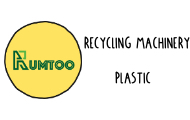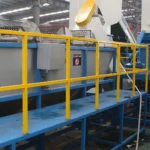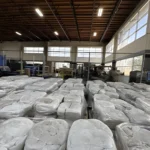An industrial plastic extruder is the equipment used to regrind or recycle plastic waste for the processes of injection molding, blow molding, or extrusion. It is used to recycle plastic products such as PP, PE, PVC, ABS, pipelines, sheets, and packaging materials. There are numerous models of industrial plastic extruders available, designed for size reduction, pelletizing, recycling machines, and accessories. Regardless of your capacity, take 5 minutes to read this blog, and you’ll gain a full understanding.
What is an Industrial Plastic Extruder?
An industrial plastic extruder is a machine that recycles plastic. It can be used for a variety of plastic and rubber materials, such as plastic profiles, pipelines, rods, films, and plastic products. The RUMTOO Machinery industrial plastic extruder is a machine that transforms raw plastic materials into pellets. It is commonly used in the recycling and reuse processes of plastics, as well as in the production of new plastic products, and it can help easily achieve recycling and ESG goals!
How Does a Plastic Extruder Work?
A rigid plastic extruder is a type of equipment that transforms raw rigid plastic materials into granular form. The operating principle generally includes the following steps:
- খাওয়ানো: Rigid plastic waste or raw materials are placed into the extruder’s feeding hopper.
- Heating and Melting: The plastic is heated to a molten state using a heating device.
- Extrusion: The molten plastic is pushed through by the screw.
- Pelletizing: The extruded plastic is cut into pellets using the extruder.
- Cooling: The pellets pass through a cooling device to solidify and take shape.
- Screening: The pellets are sorted through a screening device to remove unqualified pellets.
The exact operating principle may vary depending on the type and design of the extruder, but the general idea is to transform rigid plastics into pellets through the processes of melting, extrusion, pelletizing, and cooling. This operating principle allows the rigid plastic extruder to efficiently process raw plastic material and produce pellet products that meet requirements. The shape and size of the pellets can be adjusted as needed. The advantages of this equipment include:
- Improved Material Utilization: Transforming rigid plastic waste into pellets reduces waste and improves resource utilization.
- Reduced Production Costs: Recycling and reusing plastic pellets can lower raw material costs.
- High Adaptability: It can process many different types of rigid plastics, such as polyethylene (PE), polypropylene (PP), polystyrene (PS), etc.
- High Production Efficiency: A high degree of automation allows for the rapid production of large quantities of plastic pellets.
When choosing an industrial plastic extruder, you should consider factors such as equipment capacity, power, the type of plastic it is suited for, and the quality of the pellets. Additionally, attention should be paid to the safety, reliability, and ease of use of the equipment. If you need more detailed information, you can consult RUMTOO Machinery.
অনুমতি ছাড়া প্রজনন অনুমোদিত নয়।রুমটু রিসাইক্লিং মেশিনারি » Introduction to Industrial Plastic Extruders – Everything You Need to Know

 রুমটু রিসাইক্লিং মেশিনারি
রুমটু রিসাইক্লিং মেশিনারি এখন জিজ্ঞাসা
এখন জিজ্ঞাসা 



